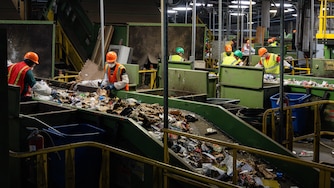Jill Hofknecht grew up on DeerPasture Drive in Columbia. But her mother wished they lived on a nearby street, about three miles away, named The Bowl.
She remembers giving her address to Baltimore businesses and medical offices and receptionists not batting an eye.
“Oh, you must live in Columbia,” Hofknecht recalled them saying.
After moving away post-college and then settling in South Jersey for nearly 30 years, Hofknecht made her way back home last fall. Soon, she was reminded of her childhood curiosity about Columbia’s street signs after spotting one, The Mending Wall, while walking her dog.
“It reminded me that I was living in the land of insane street names,” Hofknecht said.
She snapped a photo of the street sign and posted it on social media. The post caught the attention of old high school friends, who began to reminisce about other quirky street names.
Hofknecht now has an Instagram account dedicated to the offbeat monikers, @streetsofcolumbia.
When pioneering developer James Rouse mapped his vision for Columbia in the 1960s, he was a stickler for detail. So, when it came to naming streets for the emerging planned community, Rouse had thoughts.
He wanted names that distinguished Columbia and celebrated American achievements.
However, Rouse had a few stipulations.
No street names could stem from wars or technological or commercial advancements, according to the 2008 book, “Oh, you must live in Columbia! The origins of place names in Columbia, Maryland.” It was published by the Columbia Maryland Archives.
If that weren’t enough of a challenge, the U.S. Postal Service and the Baltimore Regional Planning Council chimed in with their own asks: The new Columbia streets could not repeat the names of existing ones in Baltimore City or in Anne Arundel, Baltimore and Howard counties.
Rouse assigned the task to Scott Ditch, then The Rouse Co.’s director of marketing. Ditch proposed naming the streets after authors and poets and their works.
In the book, three local authors — Missy Burke, Robin Emrich and Barbara Kellner — take readers through roughly 1,000 street names. Many honor 19th and 20th century authors and poets such as Emily Dickinson, William Faulkner, Robert Frost, J.R.R. Tolkien, Mark Twain and Walt Whitman.
For example, the Clemens Crossing neighborhood draws its name from Twain’s given name, Samuel Clemens, with the street names derived primarily from his works.
The street names in the Hobbit’s Glen neighborhood are nods to Tolkien’s writings, most famously “The Hobbit” and “The Lord of the Rings” trilogy. Hobbits’ Glen residents can live on Rivendell Lane, Wood Elves Way and Green Dragon Court.
Although few women or people of color were represented in the original street names, community leaders are seeking to change that as Columbia grows and adds new streets. The Howard Hughes company announced in 2023 that three streets in the new Lakefront neighborhood would be named in honor of Black poet Lucille Clifton.
Decades ago, Ditch left the task of assigning street names to Evelyn Menzies, a Rouse Co. research assistant.
“Overnight I went from a financial researcher to a creative researcher,” Menzies remarked, according to the book.
Menzies, who earned the nickname “Miss Columbia,” named all of the streets in four Columbia villages: Wilde Lake, Harper’s Choice, Oakland Mills and Long Reach, before leaving The Rouse Co. in 1969.
After Menzies, the street-naming job fell to various other female company employees.
Names had to be approved by Rouse, Ditch, the Postal Service and the Howard County Planning Commission. Rouse, who also developed Harborplace in Baltimore, died in 1996, and his namesake company sold Columbia in 2004.
At the Columbia Maryland Archives, located at the Columbia Association’s headquarters, you can find index cards with notations about all of the original street names. They in many cases include a phrase or a few scribbled notes.
Susan Hobby, a local author and Columbia resident, lives on Purple Twilight Way. Her street name comes from “The Last Reader,” a poem by Oliver Wendell Holmes.
Hobby recalled an urban legend that she heard as a child in Columbia, that an old woman sitting in a rocking chair smoking weed on The Rouse Co.’s roof came up with the idea of how to name the streets.
Not true, Hobby said.
“Rouse was trying to say, ‘OK, this is a place that is different. This is a place that is intentional,’ and I feel like the street names are part of that,” she added.
Hofknecht’s childhood street, which also has been spelled as Deer Pasture Drive or Deer Pasture on street signs and real estate listings, comes from the poem “In Praise of Johnny Appleseed: I. Over the Appalachian Barricade,” by poet Vachel Lindsay.
Kellner, a former archives manager who co-wrote the 2008 book, felt her street names were “really boring.” Before moving to Williamsburg, Virginia, Kellner lived on Phelps Luck Drive and Windstream Drive.
She’s not the only one who didn’t take to her address. Kellner recalled residents being upset about the naming of Wineglass Court because they didn’t want teenagers having that address.
But for Kellner the lore behind Satinwood Drive “is probably the best street story.”
For years, the street appeared on signs as Satan Wood Drive due to an egregious spelling error. It remained unfixed until a resident got it changed for good in 2005.
Kellner may have thought her street names were nothing to boast about, but the monikers caught others’ attention. On a trip in Italy, Kellner remembers giving her address at one point and being told, “You must live in Columbia.”




Comments
Welcome to The Banner's subscriber-only commenting community. Please review our community guidelines.